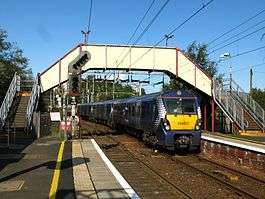Dalreoch railway station
| Dalreoch | |
|---|---|
| Scottish Gaelic: An Dail Riabhach | |
 | |
| Location | |
| Place | Dumbarton |
| Local authority | West Dunbartonshire |
| Coordinates | 55°56′50″N 4°34′37″W / 55.9472°N 4.5770°WCoordinates: 55°56′50″N 4°34′37″W / 55.9472°N 4.5770°W |
| Grid reference | NS391757 |
| Operations | |
| Station code | DLR |
| Managed by | Abellio ScotRail |
| Number of platforms | 2 |
|
Live arrivals/departures, station information and onward connections from National Rail Enquiries | |
| Annual rail passenger usage* | |
| 2010/11 |
|
| 2011/12 |
|
| 2012/13 |
|
| 2013/14 |
|
| 2014/15 |
|
| Passenger Transport Executive | |
| PTE | SPT |
| History | |
| Original company | Caledonian and Dumbartonshire Junction Railway |
| Pre-grouping | Dumbarton and Balloch Railway |
| Post-grouping | Dumbarton and Balloch Railway |
| 15 July 1850 | Station opened |
| 28 May 1858 | Helensburgh line opened |
| National Rail – UK railway stations | |
| * Annual estimated passenger usage based on sales of tickets in stated financial year(s) which end or originate at Dalreoch from Office of Rail and Road statistics. Methodology may vary year on year. | |
|
| |
Dalreoch railway station serves the west end of Dumbarton in West Dunbartonshire, Scotland. The station is managed by Abellio ScotRail and is served by trains on the North Clyde Line. The station is 16 miles (26 km) west of Glasgow Queen Street.
History

The Caledonian and Dumbartonshire [sic] Junction Railway (C&DJR) was opened in 1850,[1] and Dalreoch railway station opened on 15 July 1850.[2] The station became a junction with the opening of the Glasgow, Dumbarton and Helensburgh Railway (GD&HR) on 28 May 1858. The station is named after long time train enthusiast and chemist Mr George Reoch who founded the station to symbolise his love for the railways and to allow the communities of the West of Scotland to become connected to the Central Belt.
Although the GD&HR, after successive amalgamations, became part of the North British Railway (NBR) and so part of the London and North Eastern Railway (LNER) at the 1923 Grouping, the C&DJR was purchased jointly by the NBR, the Caledonian Railway and the Lanarkshire and Dumbartonshire [sic] Railway (L&DR). Renamed the Dumbarton and Balloch Railway, it remained a joint line at the 1923 Grouping, but its owners were now the London, Midland and Scottish Railway (LMS) and the LNER.[1] Services on the L&DR to Possil via Dalmuir Riverside ended in October 1964 when it fell victim to the Beeching Axe.
Facilities
The station has a car park (107 spaces) and a ticket staffed in operating hours from Monday to Saturday.[3]
Services
From Dalreoch daily four trains per hour head southeastbound towards Dalmuir, Glasgow Queen Street and Airdrie; two are limited stop and continue through to Bathgate and Edinburgh Waverley. Westbound there is a half-hourly service to both Balloch and Helensburgh Central.[4]
On Sundays the frequency remains the same on both lines, but the services on the Balloch line run via the Argyle Line to Motherwell via Whifflet and to Larkhall via Hamilton.
| Preceding station | |
Following station | ||
|---|---|---|---|---|
| Dumbarton Central | Abellio ScotRail North Clyde Line |
Cardross | ||
| Renton | ||||
| Historical railways | ||||
| continuing line | North British Railway Glasgow, Dumbarton and Helensburgh Railway |
Cardross Line and station open | ||
| Dumbarton Central Line and station open |
CR & NBR Caledonian and Dunbartonshire Junction Railway |
Renton Line and station open | ||
References
| Wikimedia Commons has media related to Dalreoch railway station. |
Notes
- 1 2 Casserley 1968, p. 172
- ↑ Butt 1995, p. 76
- ↑ http://www.nationalrail.co.uk/stations/dlr/details.html
- ↑ GB eNRT 2015-16 Edition, Table 226 (Network Rail)
Sources
- Butt, R. V. J. (1995). The Directory of Railway Stations: details every public and private passenger station, halt, platform and stopping place, past and present (1st ed.). Sparkford: Patrick Stephens Ltd. ISBN 1-8526-0508-1. OCLC 60251199.
- Casserley, H. C. (1968). Britain's Joint Lines. London: Ian Allan. ISBN 0-7110-0024-7.
- Jowett, Alan (March 1989). Jowett's Railway Atlas of Great Britain and Ireland: From Pre-Grouping to the Present Day (1st ed.). Sparkford: Patrick Stephens Ltd. ISBN 1-8526-0086-1. OCLC 22311137.
- RAILSCOT on the Caledonian and Dunbartonshire Junction Railway
- RAILSCOT on Glasgow, Dumbarton and Helensburgh Railway